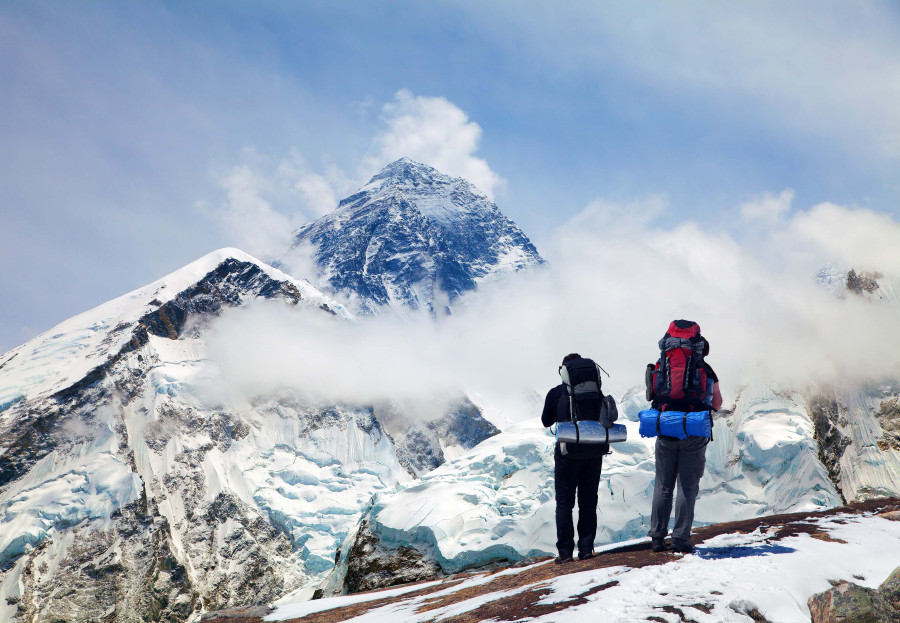Money
Coronavirus cuts foreign currency earnings from tourism by 19 percent in 2019-20, a report says
According to the central bank, revenues shrank to Rs 60.88 billion in 2019-20 that ended mid-July, a year-on-year loss of nearly Rs 15 billion.
Sangam Prasain
Nepal’s foreign exchange earnings from tourism in the last fiscal year were down 19.2 percent as the industry shuttered in the wake of the Covid-19 pandemic from March-end.
According to Nepal Rastra Bank’s annual macroeconomic report released on Monday, revenues shrank to Rs60.88 billion in the last fiscal year ended mid-July, a year-on-year loss of nearly Rs15 billion.
Foreign exchange earnings from tourism are calculated by adding the tourist service charge collected at the airport and monies earned by hotels and travel agencies, among other establishments. The calculation is also based on data received from money changers.
The government had set a tourism revenue target of Rs200 billion as Nepal was celebrating Visit Nepal 2020 expecting to attract at least 2 million visitors. But the virus played spoilsport and upended its plans.
Money flow during the four-month period extending from mid-March to mid-July totalled a paltry Rs6 billion, that too from arriving representatives of diplomatic missions and development partners, according to industry insiders.
During the period mid-April to mid-May, revenues reached a low of Rs861 million, a far cry from the average monthly income of Rs6 billion during happier times.
Arrivals during the months of April, May, June and July numbered 13, 30, 100 and 195 individuals respectively, almost all of them diplomatic personnel. Nepal used to receive more than 70,000 visitors monthly during the same period last year.
The tourism industry has never seen such a catastrophe since the first foreign sightseers began arriving in the 1950s after Nepal opened its doors to the world by establishing direct air links with several Indian cities.
Insiders say things weren't this bad even during the Maoist insurgency (1996-2006) and the 2015 earthquakes. The virus has dealt a knockout blow, and the once booming tourism sector is unlikely to get back on its feet any time soon, they say.
The global tourism industry has been devastated by the coronavirus pandemic, with $320 billion lost in exports in the first five months of the year, and more than 120 million jobs at risk, the United Nations said Tuesday.
UN Secretary-General Antonio Guterres said in a policy briefing and video address that tourism was the third largest export sector of the global economy, behind fuels and chemicals; and in 2019, it accounted for 7 percent of global trade.
“It employs one in every 10 people on Earth and provides livelihoods to hundreds of millions more,” he said. According to the UN, the export revenues from tourism could fall by $910 billion to $1.2 trillion in 2020 and that could reduce global GDP by 1.5 percent to 2.8 percent. In addition to tourism jobs that are at risk, it said.
Nepal has also witnessed job losses numbering in the tens of thousands in the tourism industry, particularly in the mountain regions that totally rely on tourism earnings.
Dhananjay Regmi, chief executive officer of the Nepal Tourism Board, said that Covid-19 had caused a big setback to the tourism industry, and job losses particularly in mountain tourism has been huge. The board, in partnership with the United Nations Development Programme-Nepal, has launched a job retention programme particularly in mountain tourism, he said.
“We have planned to employ 5,000 people to clean and repair trekking trails in three phases,” he said. "In the first phase with a Rs14 million budget, we have planned to employ at least 250 people in temporary jobs that will last up to 45 days," said Regmi. In the second phase, the board plans to allocate a Rs36 million budget.
“Workers employed in cleaning and repairing trekking trails will be paid Rs1,000 per day. In addition, the local rural municipalities will provide an additional Rs400 to Rs500 daily to the workers,” said Regmi.
The board has launched the first phase programme on three trekking routes—Khumbu trekking up to Everest base camp, Toni Hagen trekking route in Madi Rural Municipality in Kaski and a trekking trail in Annapurna base camp.
“This is the beginning. As the tourism sector doesn’t look like getting on track immediately, we have planned to launch more job retention programmes in the future,” said Regmi.
The government said on July 20 that international and domestic flights would resume starting August 17, and asked the travel and tourism industry to accept bookings for the autumn season accordingly. But the rising number of coronavirus cases made the officials backtrack.
Again on August 21, the government decided to re-start charter and regular passenger flights from September 1. But only Nepalis and representatives of diplomatic missions, the United Nations and development partners will be allowed to fly into Nepal, and restrictions on foreign tourists will remain in place until further notice.
Tourism earnings on a monthly basis
Monthly Earning
Mid-June to mid-July Rs3.02 billion
Mid-May to mid-June Rs1.23 billion
Mid-April to mid-May Rs861 million
Mid-March to mid-April Rs1.65 billion
Mid-Feb to mid-March Rs5.09 billion
Mid-Jan to mid-Feb Rs6.26 billion
Mid-Dec to mid-Jan Rs5.89 billion
Mid-Nov to mid-Dec Rs8.95 billion
Mid-Oct to mid-Nov Rs9.60 billion
Mid-Sept to mid-Oct Rs6.89 billion
Mid-Aug to mid-Sept Rs6.67 billion
Mid-July to mid-Aug Rs4.71 billion
(Source: Nepal Rastra Bank)




 10.12°C Kathmandu
10.12°C Kathmandu














